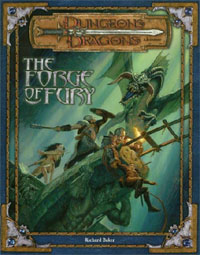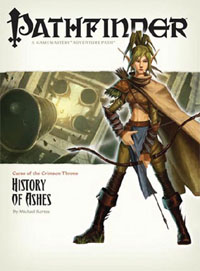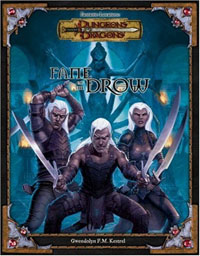In “Revisiting Encounter Design“, I make the argument that 3rd Edition plays better if you use old school encounter design. To briefly sum up:
- Design most encounters around an EL 2 to 4 lower than the party’s level.
- Feel free to use large mobs (10+ creatures) with an EL equal to the party’s level.
- Sparingly use encounters with an EL equal to the party’s level.
- Occasionally throw in an EL+2 or EL+4 encounter.
Using this encounter design results in faster combats (which means you accomplish more in a typical game session) and drastically reduces the likelihood of the 15 minute adventuring day.
This advice is not radically different from that provided in the 3.5 DMG, which suggests that encounters should be 30% with ELs lower than the party’s level, 50% with ELs equal to the party’s level, 15% with ELs 1-4 higher than the party’s level, and 5% with ELs 5+ above the party’s level. (Let’s call this the 30/50/15/5 ratio for easy reference.)
THE ANALYSIS
 This 30/50/15/5 ratio was not atypical in early 3rd Edition modules. For example, here’s the EL breakdown of combat encounters in the first section of The Forge of Fury (designed for a group of 3rd to 5th level characters):
This 30/50/15/5 ratio was not atypical in early 3rd Edition modules. For example, here’s the EL breakdown of combat encounters in the first section of The Forge of Fury (designed for a group of 3rd to 5th level characters):
EL 1
EL 2 (x7)
EL 3 (x3)
EL 4 (x4)
EL 5 (x4)
EL 10
If we use an average party level of 4th, this ratio breaks down to: 55/20/20/5. Not an exact match, obviously, but definitely within the ballpark of having 80% of your encounters equal to your lower than the party’s level.
 But as you look at modules published in the last 5-6 years, the misguided “common wisdom” of how to design encounters for 3rd Edition had taken hold. For example, here’s the encounter breakdown from part four of Paizo’s Curse of the Crimson Throne (designed for 10th level characters):
But as you look at modules published in the last 5-6 years, the misguided “common wisdom” of how to design encounters for 3rd Edition had taken hold. For example, here’s the encounter breakdown from part four of Paizo’s Curse of the Crimson Throne (designed for 10th level characters):
EL 8
EL 10
EL 11 (x2)
EL 12 (x2)
EL 13
EL 14 (x3)
That’s a ratio of 10/10/80/0. 80% of the encounters are now above the party’s average level instead of below it.
 You can see the same design principles in Wizard’s modules. For example, here’s Fane of the Drow (designed for 4th level characters):
You can see the same design principles in Wizard’s modules. For example, here’s Fane of the Drow (designed for 4th level characters):
EL 3
EL 4 (x4)
EL 5 (x5)
EL 6 (x5)
EL 7 (x2)
Which is roughly 5/25/70/0.
Similarly, here’s the breakdown from “The Demon Council”, the last section of Expedition to the Demonweb Pits (for 11th level characters):
EL 10 (x2)
EL 11 (x3)
EL 12 (x10)
EL 13 (x4)
EL 14 (x2)
Which gives us a ratio of 10/15/75/0. (This one looks a little better if you assume that the PCs are supposed to level up to 12th halfway through this sequence.)
THE TIP
A couple weeks ago, as I looked over my recent usage of published 3rd Edition scenarios, I realized that I’ve been instinctively using modules published in the last 5-6 years when the PCs are 2-3 levels higher than the recommended level.
For example, when you apply this guideline to the modules used above you end up with:
- Curse of the Crimson Throne 4: 50/10/30/0
- Fane of the Drow: 60/30/10/0
- “The Demon Council”: 70/20/10
Which definitely slants them back into the ballpark of what we’re looking for.
Reflecting on this also taught me something new: The tips in “Revisiting Encounter Design” are designed to widen the dynamic range of your encounters. Shifting the recommended level for these published modules made me realize that we’re also widening the dynamic range of our adventure design.
Fane of the Drow, for example, isn’t unachievable for 4th level characters. But it is a tough slog. And if you use “tough slog” as your baseline for normalcy, then you have nowhere to go: If your 4th level characters face anything tougher than this, their odds of dying horribly begin to skyrocket. Which means that if your 4th level characters “skip ahead” or take an unexpected shortcut, they could easily run headlong into a deathtrap.
But if Fane of the Drow is, instead, your expected baseline for 5th or 6th level characters, suddenly you’ve got room to breathe.
And where would having room to breathe become particularly important? Node-Based Scenario Design.
Revising your approach to encounter design allows you to be more fluid and dynamic in how you run and combine your encounters; it also allows you be more fluid and dynamic in how you run and combine your scenarios.












I think part of this has to do with what it means to “win.”
If winning means finishing the scenario, then the challenge lies in finishing the scenario in one piece, so it should be really hard; making it easy is anticlimactic.
If winning means exploring a cool setting, overcoming numerous challenges, getting paid, and having the adrenaline of a bit of terror and violence, and adding to the legend of a character’s development, then having more encounters and more flexible encounters is useful.
When I realized that my victory conditions as DM are seeing to it that everyone including myself has a good time, that changes my approach to the game. The challenges are there to provide a better story, delay and increase the gratification, and give the players and characters a chance to shine. The setting is a foil for the characters, the characters are not a foil for the setting. Characters are made to overcome challenges, so they need cool challenges to overcome. Making them feel barely adequate, however, isn’t the goal.
Always interesting. Thanks for sharing.
Over the years, I’ve learned a harsh lesson on encounter design.
Nowadays, I have to keep something pertinent in mind at all times when I’m running:
Let them kick some ass.
At first, I thought that having fun meant overcoming challenges in the sense that the most memorable battles were the ones that were the hardest fought. That the game experience would be more rewarding for them after really working for it and succeeding.
So a lot of my encounters were made to be at least the player’s encounter level and using every single trick that they were capable of given their abilities (using intelligent enemies intelligently, for example).
The result of this mentality meant that my players had to do everything they could just to remain competative with my counters and I frequently had issues with overestimating what my players were capable of.
I’ve been reminded a number of times about the players, being 4th~5th level in 3.5e at the time, facing off against an ogre mage whose first action was releasing his cone of cold and murdering the weakest character outright and damaging the other players. I was convinced that they could beat him (I figured they would rush him and beat him to death with his low hp and AC before he could get off another action.
Instead, they ran away, given that half damage was the only reason that they had survived anyway.
It took me a long time to realize that, as that was only the clearest example, but I’ve found a lot of advantages in using such widely varied encounters.
For starters, it lets the players feel as though as they should be. I remember Alexander’s essay (the very thing that first brought me here) about “calibrating your expectations” for D&D.
7th level fighters or strong heroes are big damn heroes with superior training that they would represent the greatest talents in the world at what they do. Letting them act like it against the weaker encounters allows them to walk that walk.
It also makes those tougher encounters all the more meaningful.
I suppose the newer encounter design philosophy works okay – they’re substituting weaker encounters for moderate ones as the majority of encounters, but it seems counter to a play experience that I’ve learned over the course of several years of dungeon mastering.
Then again, I don’t really use published adventures much at all, so I suppose it’s largely irrelevant to me.
All true Justin, weaker encounters allow for more player-input regarding the difficulty of the game: as they can then choose how many encounters to face, and have a safety margin to deal with the unforeseen.
The monsters can also respond to strategic player mistakes by combining encounters without that being instant death for the PCs.
Another tip regarding composition, I rather like to limit hostile NPCs to the same level as the PCs, and then only with one of them. There can be potential threats much greater than that, if the PCs insist on facing them, but they shouldn’t be used in a way that forces a fight. So when your 16th level party finally faces the local BBEG, it’s just a 16th level Wizard and his henchmen, albeit on home turf.
I was comparing Forge of Fury to the advice for dungeon creating and stocking in the DMG, and I think Forge of Fury is much like an example of using that system.
I’ve run it once, and I’m getting ready to run it again. Except for the challenge at the end, it’s a well-balanced and entertaining experience.
**SPOILER**
With the dragon, it’s less the creature itself and more the circumstances. With a flying creature who has a breath weapon, when the only ways out are underwater or climbing a tall cliff, and the dragon can attack from underwater and play hit and run as much as seems amusing as well as seeing in pitch darkness… I don’t know how the characters have much of a chance.
I played up the dragon’s youth and it got cocky, showing off and attacking in hand to hand after a little hide-go-spit. Or they would have died, through no fault of their own.
[…] er to design-tilgange her, hvis vi følger The Alexandrians diskussion af encounter levels og udfordringer i D&Ds forskellige versioner. I de tidlige udgaver af D&D, var der ikke et […]
I think my own experience matches yours, but for what I think is a slightly different reason – namely that using the modules essentially as written but actually extrapolating a reasonable level of organization and response those “1st-3rd” level adventures were actually quite a challange for 4th-5th level characters.
Perhaps I’m smarter than my players were, but I invariably know the rules better – and with a couple of notable exceptions certainly had a much better sense of tactics.
But it also went with what Joshua said above, it lets the players kick some ass with a number of things, and then made the bosses much more of a challenge because they really did have to work for those victories (when they got them – more often than not, the boss ran away to fight another day…)
I must caveat all of this with the note that I stopped playing with 2E and never hopped on the any of the 3E bandwagons (and have kind of shuddered when I bought a couple of the newest version).
D.
FWIW, Curse of the Crimson Throne is an adventure path. It comes in 6 parts, and part 4 is supposed to take characters from level 10 to 12. Assuming that level 11 is thus “average”, the ratio would be closer to 20/20/60/0. Not really a huge difference, but still worth noting.
A true overview, of course, can’t be had without actually going through the entire adventure path, counting up XP, and noting when the characters level up.
My point, though, is that analyzing an adventure for characters of level 10-12 as an adventure for level 10 characters only is a little bit unfair.
To unpack my analysis a bit: The title page of the module states that the “scenario was designed for four 10th-level characters. By the end of the adventure, characters should reach 11th level.” That means the average party level is 10.5 (round down to 10). In addition, IIRC, it looked to me like the EL 11 encounters took place early enough in the adventure that the party was unlikely to have leveled before hitting them. (As opposed to Fane of the Drow where, as I noted, the level-up was likely to have an impact
It also looked to me at the time that the intention was “the last batch of XP will put them at 11th level”. But looking at part 5 of the series I can see that it’s assuming 12th level characters… which is weird.
Okay, doing a quick XP spot-check it looks like a group with 4 10th-level PCs who starts more than half-way to 11th level will earn enough XP to scrape into 12th level if they hit all of the encounters. Probably a typo on the title page, then? Still, it looks like at least one and probably both of the EL 11 encounters will happen before the level-up to 11th, so the ratio still looks fairly accurate.